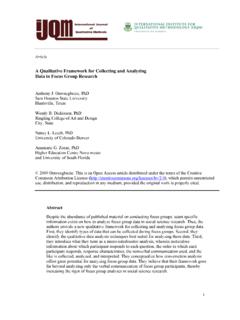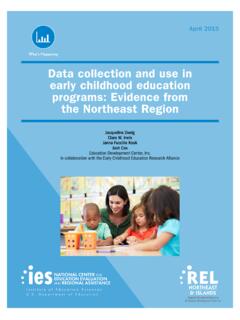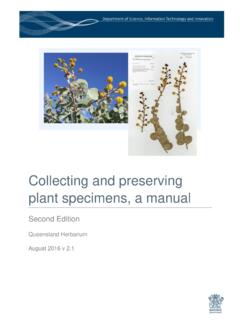Transcription of COLLECTING DATA IN MIXED METHODS RESEARCH
1 110 CHAPTER6 COLLECTING DATAIN MIXED METHODSRESEARCHR esearchers collect data in a MIXED METHODS study to address theresearch questions or hypotheses. The data collection procedureneeds to fit the type of MIXED METHODS design in the study. Thisrequires using procedures drawn from concurrent forms of data collection,in which both the quantitative and qualitative data are collected concurrently,or from the sequential forms of data collection, in which one type of data iscollected and analyzed prior to a second data collection.
2 Issues develop dur-ing both of these approaches that the investigator must address. However,before discussing the MIXED METHODS data collection procedures, we willbegin with a review of the basic elements of both quantitative and qualitativedata collection within a process approach to chapter will address The procedures for quantitative and qualitative data collection in aresearch study MIXED METHODS data collection procedures for the MIXED meth-ods designs based on concurrent and sequential forms of datacollection06-Creswell (Designing) 5/16/2006 8.
3 59 PM Page 110 PROCEDURES IN QUALITATIVE AND QUANTITATIVE data COLLECTIONWhen researchers think about data collection, they often turn to the specifictypes of data collection and the procedures for COLLECTING that data . Webelieve that there are some phases to the process of data collection that,in combination, comprise the data collection step in RESEARCH . As shown inTable , these phases are the sampling procedures, permissions, typesof information collected, forms for recording the data , and the activitiesinvolved in administering the data collection.
4 Each phase will be discussedindividually for both qualitative and quantitative data collection as a reviewprior to discussing MIXED METHODS data collection. The review is adaptedfrom several chapters in Creswell (2005a). COLLECTING data in MIXED METHODS RESEARCH 111 Quantitative data Collection Random sampling Adequate size to reducesampling error and providesufficient power From individuals providingaccess to sites Institutional review boards Individuals Instruments Checklists Public documents Instruments with scores that arereliable and valid Standardization of procedures Attending to ethical issuesPhases in the Processof ResearchSamplingPermissionsData sourcesRecording the dataAdministering datacollectionQualitative data Collection Purposeful
5 Samplingstrategies Small number of participantsand sites From individuals providingaccess to sites Institutional review boards Individuals Open-ended interviews Open-ended observations Documents Audiovisual materials Interview protocols Observational protocols Attending to field issues Attending to ethical issuesTable in the data Collection Process for Qualitative and Quantitative Research06-Creswell (Designing) 5/16/2006 8:59 PM Page 111 Sampling ProceduresTo address a RESEARCH question or hypothesis, the researcher decideswhich people and RESEARCH sites can best provide information, puts a sam-pling procedure in place, and determines the number of individuals that willbe needed to provide qualitative RESEARCH , the inquirer purposefully selects individualsand sites that can provide the necessary information.
6 Purposeful samplingmeans that researchers intentionally select participants who have experiencewith the central phenomenon or the key concept being explored. A numberof purposeful sampling strategies are available, each with a different of the more popular is maximal variation sampling, in which individualsare chosen who hold different perspectives on the central phenomenon. Thecriteria for maximizing differences depends on the study, but it might berace, gender, level of schooling, or any number of factors that would differ-entiate participants.
7 The central idea is that if participants are purposefullychosen to be different in the first place, then their views will reflect this dif-ference and provide a good qualitative study. Another approach is to useextreme case sampling of individuals who provide unusual, troublesome, orenlightened cases. In contrast, a researcher might use homogeneous sam-pling of individuals who have membership in a subgroup with terms of numbers, rather than selecting a large number of people orsites, the qualitative researcher identifies a small number that will providein-depth information about each person or site.
8 The larger the number ofpeople, the less the amount of detail typically emerging from any one indi-vidual and a key idea of qualitative RESEARCH is to provide detailed views ofindividuals and the specific contexts in which they hold these views. Manyqualitative researchers do not like to constrain RESEARCH by giving definitivesizes of samples, but the numbers may range from one or two people, as ina narrative study, to 50 or 60 in a grounded theory project. Typically, whencases are reported, a small number is used, such as 4 to 10.
9 The numberrelates to the question or to the type of qualitative approach used, such asnarrative, phenomenology, grounded theory, ethnography, or case studyresearch (Creswell, 1998).In quantitative RESEARCH , the intent of sampling individuals is to chooseindividuals that are representative of a population so that the results can begeneralized to a population. In this way, investigators first select their popula-tion and define it carefully. Then they choose a sample from this not always workable, random choice of individuals for the sample isattempted so that each person in the population has an equal chance of being112 DESIGNING AND CONDUCTING MIXED METHODS RESEARCH06-Creswell (Designing) 5/16/2006 8:59 PM Page 112selected.
10 Probabilistic samplinginvolves randomly choosing individuals basedon a systematic procedure, such as the use of a random numbers table. Inaddition, the investigator may want certain characteristics represented in thesample that may be out of proportion in the larger population. For example,more females than males may be in the population, and a random sam-pling procedure would, logically, oversample females. In this situation, theresearcher first stratifies the population ( , females and males) and thenrandomly samples within each stratum.















